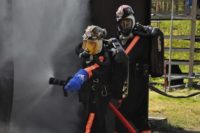Mine rescue teams test skills at training academy


|
Nearly 60 mine rescue teams gathered recently at the Mine Safety and Health Administration’s training academy to test their ability to fight fires, navigate through dense smoke and rescue trapped miners.
Teams gathered in Beaver, West Virginia were confronted with various scenarios they may encounter during real mine emergencies.
"With terrible tragedies like what happened at Upper Big Branch, Sago and Aracoma over the past several years, it is clear that the U.S. mining industry still needs the valuable expertise that well-trained mine rescue teams deliver," said MSHA Assistant Secretary Joseph Main. "When a mine emergency strikes, there is nothing more comforting than the presence of prepared, competent mine rescue teams."
On public display were several components of MSHA's Mine Emergency Operations unit, including the seismic location vehicle, mobile gas laboratory, mine rescue robot and command center truck, which recently was equipped with a state-of-the-art surface-to-underground communications and tracking system.
"Effective mine rescue entails many different parts working together seamlessly toward one goal," said Main. "One of the most important things we can do is to prepare ourselves as best we can for a mine emergency."
Looking for a reprint of this article?
From high-res PDFs to custom plaques, order your copy today!




